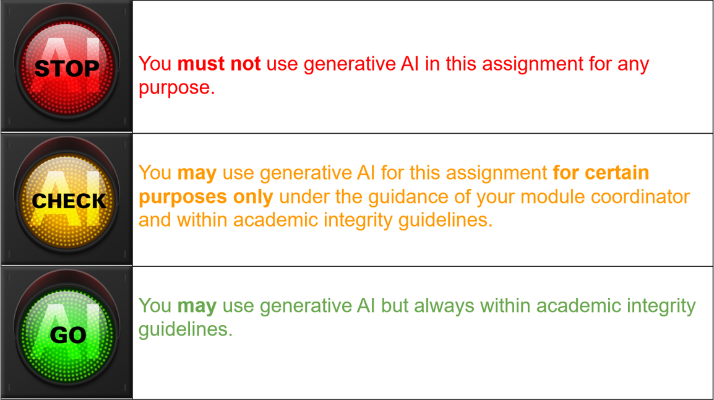Traffic Light System for Generative AI Use in Module Assignments: UCD College of Arts and Humanities
What is the traffic light system?
From spring 2024 UCD College of Arts and Humanities is adopting a traffic light system to indicate whether or not students can use generative AI in their assignments.
How does the traffic light system work?
Under the traffic light system, individual assignments are marked red (you must not use generative AI in this assignment for any purpose), amber (you may use generative AI for this assignment for certain purposes only under the guidance of your module coordinator and within academic integrity guidelines) or green (you may use generative AI but always within academic integrity guidelines) to provide clear guidelines to students about whether or not they are permitted to use generative AI in their work.

Links to download thumbnail images:
Why has the College of Arts and Humanities introduced the traffic light system?
The traffic light system aims to provide clear guidelines to students about whether or not they can use generative AI in their assignments and to promote a culture of transparency around the use of generative AI. The traffic light system was approved by the College of Arts and Humanities Programme Board and the Teaching and Learning Committee in autumn 2023.
What kinds of uses of generative AI might be permitted in my assignment?
If yours is an amber or green assignment that permits (some) use of generative AI, you may choose to use it in a range of ways. With an amber assignment your module coordinator will set the limits on potential uses; with green you will set the limits yourself. Some examples of potential educational uses of generative AI are shared below. Please note that these will not be suitable or beneficial for all types of assignments so please be guided by your module coordinator if you are unsure.
| Correction | Correct spelling, grammar and punctuation |
| Translation | Translate passages of text |
| Citation | Arrange references according to a particular citation style |
| Improvement | Improve the style and tone of writing |
| Feedback | Get feedback on some draft material |
| Unpacking | Unpack an assignment prompt to better understand it |
| Brainstorming | Brainstorm a topic to gather a range of approaches |
| Planning | Generate a research plan |
| Structuring | Devise a structure for a piece of writing based on an abstract, introduction, or general ideas |
| Revision | Revise a piece of writing |
If you are permitted and choose to use generative AI, then you must ensure that you use it critically, ethically, and responsibly. Further information can be found on this website.
How does a module coordinator decide whether or not to permit the use of generative AI?
In deciding whether or not to permit the use of generative AI, module coordinators must weigh the potential benefits and costs to students’ learning. The balance of benefits and costs may vary from module to module because of the specific goals of the assignment and the intended learning outcomes of the module.
What if I disagree with the decision my module coordinator has made about the use of generative AI?
If you disagree with the decision about the use of generative AI then you can bring your concerns to the module coordinator. But please be aware that the module coordinator sets the module learning outcomes and assessment strategy and is ultimately responsible for ensuring the academic integrity of the module. Whatever your personal view, you must follow assessment protocol in this as in other matters.
My assignment is amber or green but I do not want to use generative AI for my work. What should I do?
You don’t have to use generative AI if you don’t want to! Amber and green modules permit (some) use of generative AI but do not require it. Just as your module coordinator weighs the potential benefits and costs of the use of generative AI, so should you. Your decision must take into consideration your own learning needs and goals.
How can I use generative AI within the academic integrity guidelines?
The UCD Plagiarism Policy and academic integrity guidelines require students to acknowledge their use of generative AI. If permitted, your module coordinator will provide guidelines on how you should acknowledge your use of generative AI, but it is likely to be one of the following:
| Include prompts and/or chat session | Share document history | Write a description | Write critical reflection |
| Provide an appendix with a list of prompts and/or links to the entire conversation with GenAI. | Show track changes or provide access to the document history to show the writing, revision, and editing process. | Write a short description of how GenAI was used in the preparation of the assignment. | Write a critical reflection on how GenAI was used in the preparation of the assignment and what was learned from the process. |
I want to experiment with generative AI; where do I start?
Students have access to (opens in a new window)Google Bard through UCD so you can experiment with generative AI without having to set up an account with a third party (such as Open AI’s Chat GPT).
How can I learn more about generative AI?
There is a wealth of information about generative AI on this website including some Key Messages, FAQs, and Glossary. The range of videos, podcasts and infographics among the Specially Curated Resources may be particularly useful.